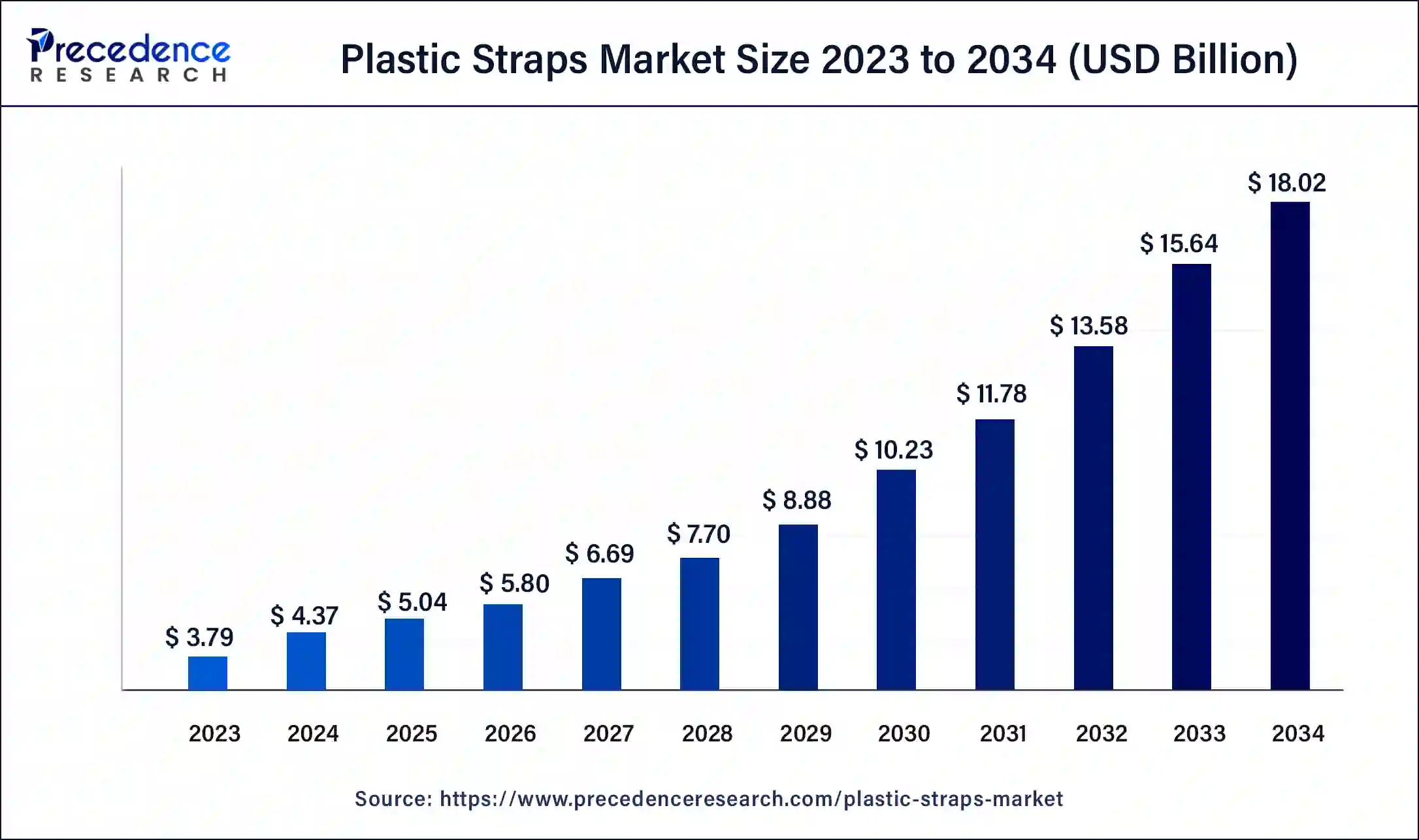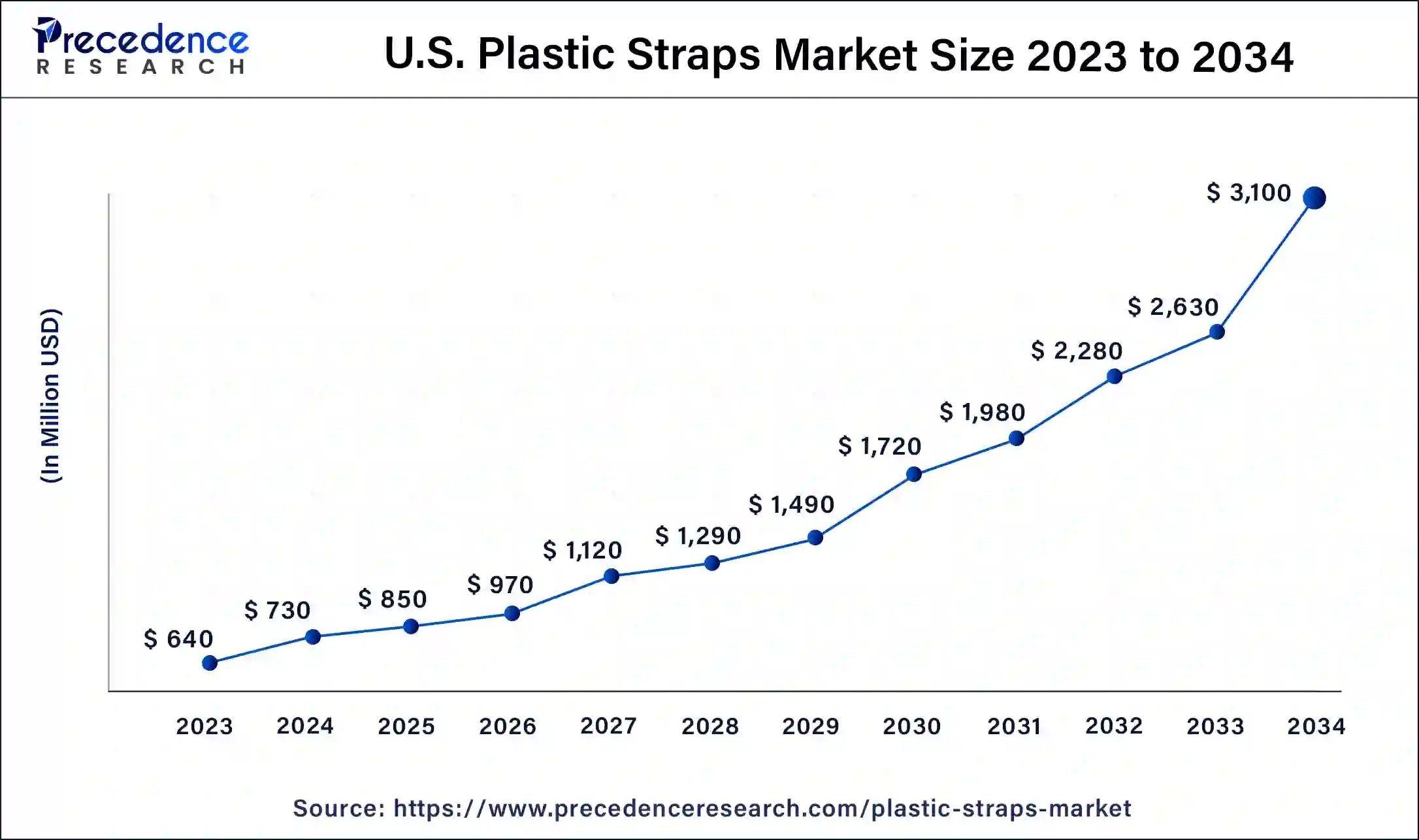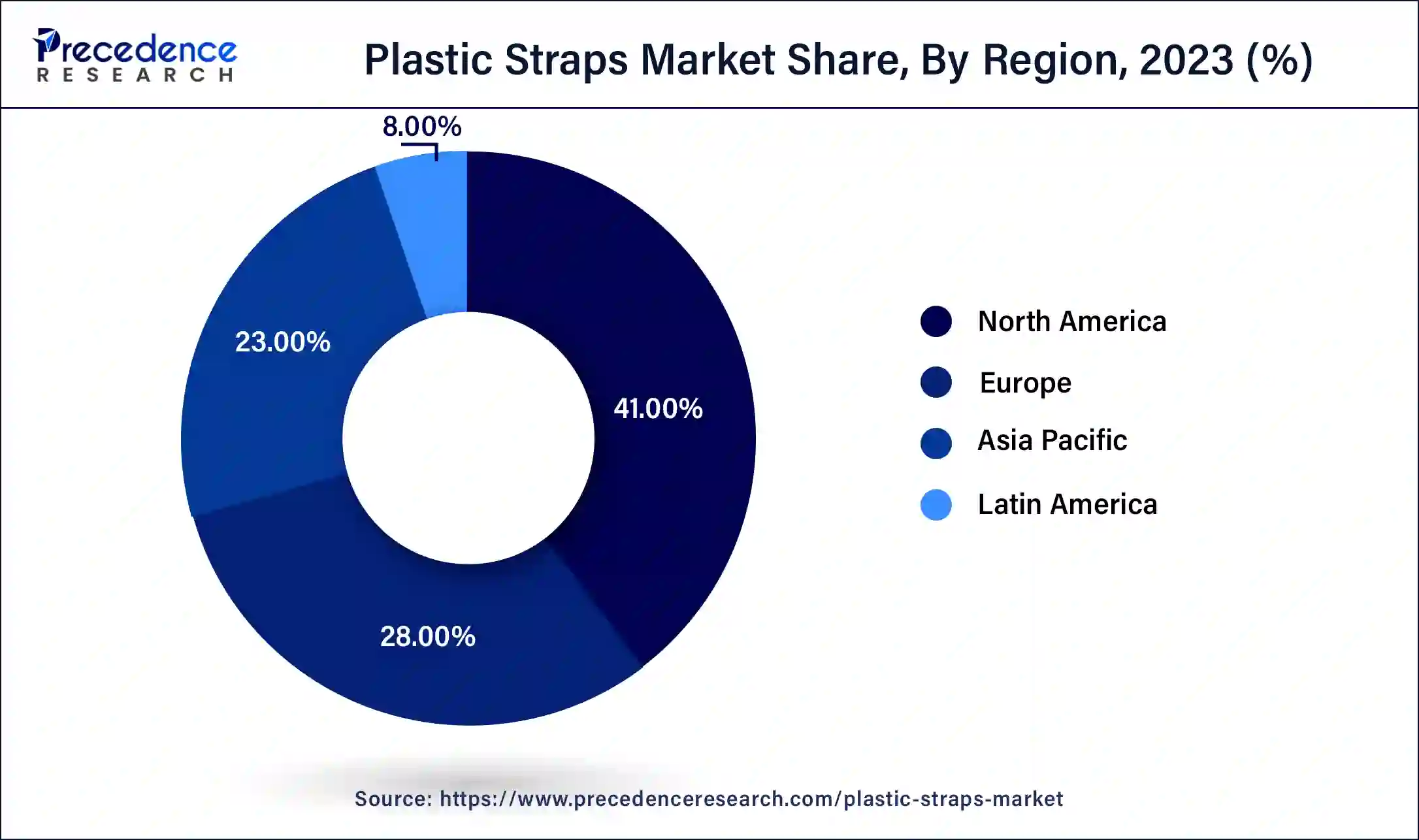April 2025
The global plastic straps market is worth around USD 4.37 billion in 2024 and is expected to reach around USD 18.02 billion by 2034, representing a healthy CAGR of 15.22% during the forecast period from 2024 to 2034.
The global plastic straps market size is expected to be worth USD 4.37 billion in 2024 and is anticipated to reach around USD 18.02 billion by 2034, growing at a solid CAGR of 15.22% over the forecast period 2024 to 2034. The North America plastic straps market size reached USD 1.55 billion in 2023. The increasing packaging industries, e-commerce expansion, enhanced recycling infrastructure, logistic sector expansion, heavy material transportation, online delivery, logistics, manufacturing, construction, supply chain, etc., driving the growth of the market.

The U.S. plastic straps market size was exhibited at USD 640 million in 2023 and is projected to be worth around USD 3.10 million by 2034, poised to grow at a CAGR of 15.42% from 2024 to 2034.

North America dominated the plastic straps market in 2023. The materials of plastic packaging are making it more sustainable to transport, which is raising the demand for plastic straps in the market. The increasing use of advanced products is a trend that, together, significantly raises the market size. The availability of additional major players fueled the growth of the market.

Asia Pacific is estimated to be the fastest-growing during the forecast period of 2024-2034. In manufacturing sectors, multinational investments are advancing economies. Packaging manufacturer’s goal is to expand both their clientele and global presence to meet necessities in this sector. Plastic straps become more popular due to the increasing e-commerce industry and people's increased demand for online shopping and home delivery, which contributes to the growth of the plastic straps market.
The plastic straps market refers to the buying and selling of plastic straps, which is a high tensile strength banding material that is used for a wide variety of packaging applications, plastic tote security, bundling, carton closing, and tying together both unpalletized and palletized material for in-plant transfer and shipment. The benefits of plastic straps include not eroding over time and being non-corrosive, it can withstand wear and tear, high elongation with low break loads force in lbs., and it is more affordable than HR nylon and polyester.
The use of artificial intelligence (AI) plays an important role in the plastic industry, including the production and use of plastic straps. The benefits of AI use in plastic straps include quality control and detection of defects, reduced downtime and maintenance costs, supply chain optimization, ensures that plastic strips are produced and delivered effectively, production of plastic straps is more sustainable, etc., contributing to the growth of the plastic straps market.
| Report Coverage | Details |
| Market Size by 2034 | USD 18.02 Billion |
| Market Size in 2023 | USD 3.79 Billion |
| Market Size in 2024 | USD 4.37 Billion |
| Market Growth Rate from 2024 to 2034 | CAGR of 15.22% |
| Largest Market | North America |
| Base Year | 2023 |
| Forecast Period | 2024 to 2034 |
| Segments Covered | Type, Application, End-use, and Regions |
| Regions Covered | North America, Europe, Asia-Pacific, Latin America and Middle East & Africa |
Driver
Growing demand for plastic straps in many industries
The growing demand for plastic straps in many industries, the transportation of heavy materials, online delivery, e-commerce, pharmaceutical, electronic, food, and beverage, has led to an increase in contributing to the growth of the plastic straps market. The benefits of plastic straps used for packaging include sustainability and recyclability, branding and customization, ease of application, resistance to weather conditions, palletized shipments, the packaging of heavy and bulky items, etc.
Presence of alternative materials
The presence of alternative materials, the high cost of raw materials, lower tensile strength compared to steel straps, susceptibility to degradation from weather exposure and extreme temperatures, etc., can hamper the plastic straps market growth. The alternatives for plastic straps include textile straps, metal straps, fabric straps, polypropylene ropes, paper straps, etc., which can restrain the market’s growth.
Future of plastic strap
The future of plastic straps includes the benefits of customized printing on plastic straps, can be developed with chemical resistance, will not rot or rust, self-adjusting, cost-effective, easy to handle, is stronger than steel, efficiently reduces strapping-related worker mishaps, etc., helps to the growth of the plastic straps market. Plastic straps are the heroes of the packaging world. Logistic sector expansion and increased recycling infrastructure will help the market’s growth in the future.
The polyester segment dominated the plastic straps market in 2023, and it is anticipated to be the fastest-growing segment during the forecast period. The benefits of polyester strapping include shock absorbing, ecological adhesive resin, UV resistant and weatherproof, the hotmelt lamination allows controlled unrolling, environmentally responsible glue resin, strong and durable, lightweight, re-pensionable, adaptability, weather resistant, gentle on delicate surfaces and edges, cost savings, eliminated damaged costs, fewer material costs, safer alternative to steel strapping, performance and durability, polyester strapping and environment, load stability, elastic memory, etc. The applications of polyester straps include heavy-duty agriculture packaging, construction, logistics, transportation, manufacturing and distribution, recycling, consistent performance, and packaging of materials from lightweight to heavy-duty instruments.
The polypropylene segment is expected to be growing significantly during the forecast period. The benefits of polypropylene (PP) strapping include a smooth surface for easy application, durability, and flexibility, suitability for light to medium duty applications, resistance to moisture, rust, and corrosion, highly tensile strength for securely holding heavy loads, cost-effective, easy to handle and lightweight, good elasticity, durable, versatility, etc. help to the growth of the plastic straps market. Polypropylene plastic strapping is designed for light and medium-duty applications like carton closure and reinforcement, bundling, unitizing, and palletizing. Polypropylene strapping may hold items weighing up to 400 kilograms, mainly those with light elastic properties. Polypropylene straps are available in many widths; the most common options are 19 mm, 15 mm, and 12 mm straps.
The wood segment is estimated to be the fastest-growing during the forecast period. The plastic strap plays an important role in the wood/lumber industry. The wood/lumbar industry needs durable and secure strapping materials to bundle and transport wood-based products efficiently, which helps the growth of the plastic straps market.
In the wood industry, polypropylene straps are a popular choice because of their reliability and affordability. Propylene straps are cost-effective for wood businesses, which makes them a practical choice that needs a high quantity of strapping materials, and it makes a balance between affordability and strength. The propylene strap is lightweight, which makes it easy to handle during transport and packaging. Polypropylene strap is moisture resistant, which helps to maintain bundle integrity and prevent deterioration.
The industrial logistics and warehouse segment dominated the plastic straps market in 2023, and the segment is anticipated to be the fastest-growing during the forecast period. The plastic strap provides superior protection and logistics, ensuring that the products remain intact at the time of transit. In many manufacturing and industrial environments, securing products for transportation and storage is important. In many industries, plastic straps are used in warehouse settings, automotive, metalworking, food and beverage industries, shipping and logistics, construction, etc.
Segments Covered in the Report
By Type
By Application
By End-use
By Geography
For inquiries regarding discounts, bulk purchases, or customization requests, please contact us at sales@precedenceresearch.com
No cookie-cutter, only authentic analysis – take the 1st step to become a Precedence Research client
April 2025
September 2024
September 2024
August 2024